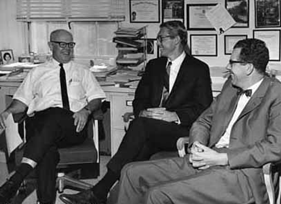- 1610: Galileo
- 1676: Ole Rømer
- 1687: Isaac Newton
- 1781: William Herschel
- 1838: Friedrich Bessel
- 1861: William and Margaret Huggins
- 1912: Henrietta Leavitt
- 1917 Einstein
- 1920: Harlow Shapley
- 1929 Edwin Hubble
- 1948: Ralph Alpher
- 1949: Fred Hoyle
- 1963: Maarten Schmidt
- 1964: Arno Penzias and Robert Wilson
- 1978: Vera Rubin and Kent Ford
- 1989: Margaret Geller and John Huchra
- 1992: John Mather and George Smoot
- 1995: Robert Williams
- 1998: Saul Perlmutter and Brian Schmidt
- 2010: Wendy Freedman
1963: Maarten Schmidt Discovers Quasars
 |
| Credit: AIP Emilio Segre Visual Archives, Clayton Collection. |
The discovery of Quasars in 1963 provided a final piece of evidence that undermined the Steady State theory of the universe, and supported the Big Bang. Maarten Schmidt, a Caltech astronomer working at Mt. Palomar Observatory, was credited with discovering the most distant object observed to date—so bright that it was mistaken for a star; but it was billion light years away. Because of the Doppler shift, the characteristic lines with which we identify stars were not at the expected wavelengths.
Schmidt’s discovery capped an exciting period in which the distance scale of the universe was expanded nearly tenfold, thanks to the contributions of Walter Baade, Alan Sandage, the new science of radio astronomy, and the magnificent telescopes of Mount Palomar.
Not all radio sources can be seen in visible light. Many are thought to be distant galaxies. The Sun emits radio waves that are easily detected because it is so close to us, but most stars are not bright radio sources. In 1963 Maarten Schmidt was studying radio Source 3C 273. It was unusual because the radio signals appeared to be coming from a star. At first the spectrum of the star was puzzling. Schmidt could not figure out what elements produced the bight spectral lines. Then he realized that the unfamiliar lines were simply the bright emission lines from hydrogen gas that had been shifted to different wavelengths. According to Hubble’s Law, an object with that red shift must be located billions of light-years away. It must be brighter than a million galaxies to appear as bright as a star at that great distance.
3C 273 came to be known as a quasar, short for quasi-stellar radio source, since it looks like a star, but cannot possibly be one since it is so bright. In subsequent years many more quasars were found, including some much further away than 3C 273. These findings dealt a serious blow the Steady State theory, which proposed that the universe is more or less uniform, so that young galaxies should be distributed evenly, with some close and some far away. If quasars are only found at great distances, they could very well be young galaxies, since we are seeing them much earlier in the history of the universe. (Light from an object a billion light years away takes a billion years to reach us.) Therefore, Maarten Schmidt’s discovery of quasars added another important piece of evidence in favor of the Big Bang theory. It also amazed the readers of Time magazine that astronomers could look so far away in space and time.